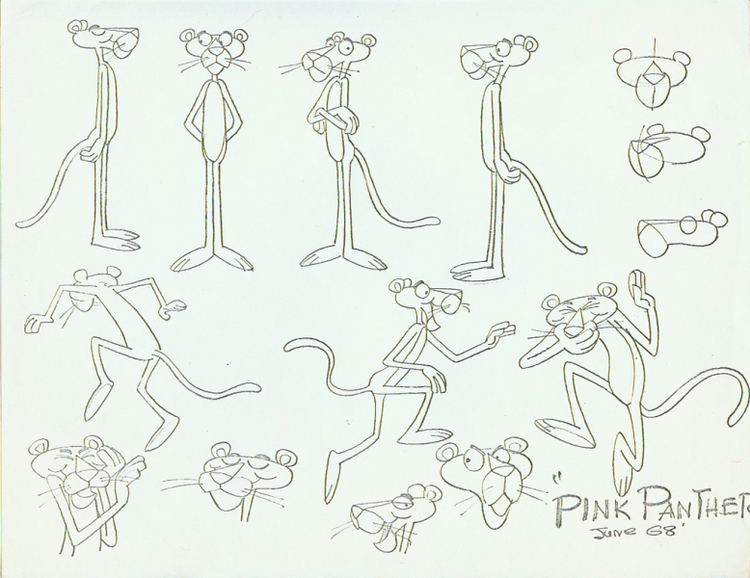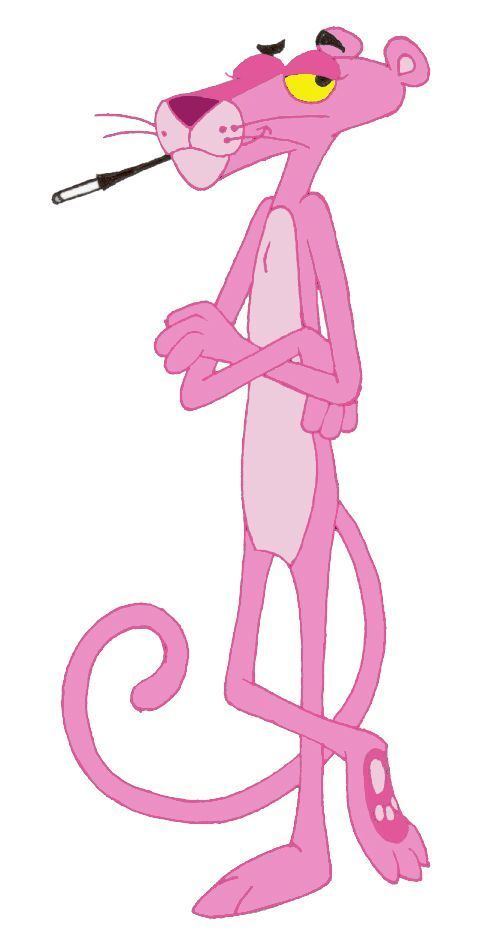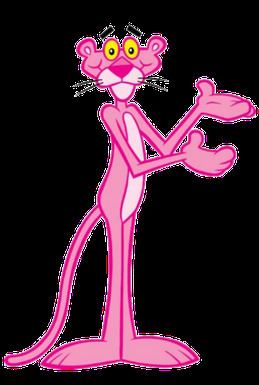Aliases PinkPinky Gender Male | ||
 | ||
Voiced by Mel Blanc (vocal effects, 1964-1981, uncredited)Rich Little (Sink Pink, Pink Ice), Matt Frewer (The Pink Panther) (1993 TV Series)Michael Sinterniklaas (Passport to Peril, Hocus Pocus Pink) Movies Sink Pink, Pink Pull, Driving Mr. Pink, Pink Ice Similar Inspector Clouseau, Jerry, Tom, Woody Woodpecker, Bugs Bunny | ||
Pink Panther is a fictional animated character who appeared in the opening and closing credit sequences of every film in the Pink Panther series except for A Shot in the Dark and Inspector Clouseau. In the storyline of the original film, "the Pink Panther" was the name of a valuable pink diamond; in the animated credits this was humorously translated to a "real" pink panther.
Contents
- DePatie FrelengUnited Artists cartoons
- Pink Panther Show
- Comic book
- Later television shows and specials
- Popular culture
- Advertising
- Games
- Products
- List of animated shows
- 2006 Film
- List of animated specials
- Charity
- Critical reception
- Television
- Theatrical
- References

The character's popularity spawned a spin-off franchise of theatrical shorts, merchandise, a comic book, and television cartoons. He starred in 124 short films, 10 television shows and three prime time specials. The character is closely associated with the evocative "Pink Panther Theme".

DePatie-Freleng/United Artists cartoons

The animated Pink Panther character's initial appearance in the live action film's title sequence, directed by Friz Freleng, was such a success with audiences and United Artists that the studio signed Freleng and his DePatie-Freleng Enterprises studio to a multi-year contract for a series of Pink Panther theatrical cartoon shorts. The first entry in the series, 1964's The Pink Phink, featured Pink harassing his foil, a little white mustachioed man who is actually a caricature of Friz Freleng (this character is officially known as "The Little Man")), by constantly trying to paint the Little Man's blue house pink. The Pink Phink won the 1964 Academy Award for Animated Short Film, and subsequent shorts in the series, usually featuring the Pink Panther opposite the Little Man, were successful releases.
In an early series of Pink Panther animated cartoons, Pink generally remained silent, speaking only in two theatrical shorts, Sink Pink and Pink Ice. Rich Little provided Pink's voice in the latter shorts, modelling it on that of David Niven (who had portrayed Clouseau's jewel thief nemesis in the original live-action film). Years later, Little would overdub Niven's voice for Trail of the Pink Panther and Curse of the Pink Panther, due to Niven's ill health. All of the animated Pink Panther shorts utilized the distinctive jazzy theme music composed by Henry Mancini for the 1963 feature film, with additional scores composed by Walter Greene or William Lava.
Pink Panther Show

In the fall of 1969, the Pink Panther cartoons made their way to NBC television shown Saturday mornings via The Pink Panther Show. NBC added a laugh track to the original cartoons, with Marvin Miller brought on as an off-camera narrator talking to the Pink Panther during bumper segments featuring the Pink Panther and The Inspector together. The series featured a live-action introduction, over the theme song, which featured the Panthermobile.

Pink Panther shorts made after 1969 were produced for both broadcast and film release, typically appearing on television first, and released to theaters by United Artists. One version of the show was called The Think Pink Panther Show. A number of sister series joined The Pink Panther on movie screens and on the airwaves, among them The Ant and the Aardvark, The Tijuana Toads (a.k.a. The Texas Toads), Hoot Kloot, and Misterjaw (a.k.a. Mr. Jaws and Catfish). There were also a series of animated shorts called The Inspector, with the Clouseau-inspired Inspector and his sidekick Sgt. Deux-Deux, whom the Inspector is forever correcting. Other DePatie-Freleng series included Roland and Rattfink, The Dogfather (a Godfather pastiche), with a canine Corleone family and two Tijuana Toads spinoffs, The Blue Racer and Crazylegs Crane.
The German television version which started airing in 1973 in ZDF was presented in 30-minute episodes, composed of one Pink Panther cartoon, one episode of The Inspector and one episode of The Ant and the Aardvark. Most notably, the difference between the German and the English version of the Pink Panther is a rhymed narration in the German version (spoken by voice actor Gert Günther Hoffmann), commenting and describing the plot. For this show, custom intro and end sequences were cut together from existing pieces of animation.
In 1976, the half-hour series was revamped into a 90-minute format, as The Pink Panther Laugh and a Half Hour and a Half Show; this version included a live-action segment, where the show's host, comedian Lenny Schultz, would read letters and jokes from viewers. This version flopped, and would change back to the original half-hour version in 1977.
In 1978, The Pink Panther moved to ABC and was rebranded The All New Pink Panther Show, where it lasted one season before leaving the network realm entirely. The ABC version of the series featured sixteen episodes with 32 new Pink Panther cartoons, and 16 of Crazylegs Crane. The 32 entries were later released theatrically by United Artists.
Comic book
In 1971, Gold Key Comics began publishing a Pink Panther comic book, with art by Warren Tufts. The Pink Panther and the Inspector lasted 87 issues, ending only when Gold Key ceased operations in 1984. The spinoff series The Inspector (also from Gold Key) lasted 19 issues, from 1974 to 1978.
Later television shows and specials
During the final years of the Panther's theatrical run, DePatie-Freleng produced a series of three primetime Pink Panther television specials for ABC. The first was 1978's A Pink Christmas. It featured Pink in New York being cold and hungry looking for a holiday dinner. The other two specials premiered on ABC after the shorts officially ended in theaters, 1980's Olym-Pinks and 1981's Pink at First Sight. In November 2007, the three specials were released on a single disc DVD collection, The Pink Panther: A Pink Christmas from MGM Home Entertainment/20th Century Fox Home Entertainment.
The studio was sold to Marvel Comics in 1981, and became Marvel Productions (now a part of The Walt Disney Company). In 1984, a new Saturday morning series was produced entitled Pink Panther and Sons. In this incarnation (produced by Hanna-Barbera Productions with Freleng serving as creative producer for the series), the still-silent Pink Panther was a father of his two talking sons, Pinky and Panky. While popular, critics complained that there was not enough Pink Panther to maintain interest for a full 30 minutes.
A new series of cartoon were created in 1993, simply titled The Pink Panther, produced by Metro-Goldwyn-Mayer Animation, premiered in syndication in 1993, and had the Pink Panther speaking with the voice of Matt Frewer (of Max Headroom fame). Unlike the original shorts, not all episode titles contained the word "pink," although many instead contained the word "panther." Voice impressionist John Byner returned to voice both the Ant and the Aardvark.
In July 2007, Metro-Goldwyn-Mayer Inc. and Jordan's Rubicon animation company began co-production of the animated series Pink Panther and Pals portraying a teenaged panther and his friends. The 26 episode TV series premiered worldwide in spring 2010 on Cartoon Network. In 2011, a new 22-minute holiday special entitled A Very Pink Christmas aired on ABC Family and later Boomerang in the U.S., YTV in Canada, and Boomerang in the U.K. in December.
After acquiring United Artists in the early 1980s, MGM continues to own the ancillary rights and trademarks to the Pink Panther franchise.
Popular culture
The Pink Panther is known as Nathu and Pangu in East and South Asia, Paulchen Panther (Little Paul the Panther) in Germany and Пинко розовата пантера (Pinko the Pink panther) in Bulgaria. He remains a popular character. In addition to the regular airing of the classic cartoon, the panther also appears in the following:
Advertising
Games
Products
List of animated shows
2006 Film
List of animated specials
Charity
The Pink Panther is associated with a number of cancer awareness and support organisations. The Pink Panther is the mascot of the New Zealand Child Cancer foundation and for a line of clothing to promote breast cancer awareness. California based children's cancer charity The Gary L. Hoop Foundation humorously places The Pink Panther in various locations on its website and in its advertisements, paying homage to both the cartoon and their late namesake Gary Hoop, who once carried "The Pink Panther" as a nickname.
Critical reception
Animation historian Jerry Beck has called the Pink Panther "the last great Hollywood cartoon character", noting that "Classic animation pretty much died in the '60s, everyone had kind of bailed out. But his creators didn't rest on their laurels. They didn't make the cartoons to look like Warner Bros. cartoons, or Disney cartoons, or the UPA look of Mister Magoo and Gerald McBoing-Boing. They came up with their own clever new style. The only other important cartoon of the '60s was Yellow Submarine."
The Pink Panther was a notable contribution to the animation art form. Top animation directors such as Hawley Pratt, Gerry Chiniquy, Robert McKimson, and Sid Marcus contributed to a distinctive style, supported by master story writer John W. Dunn. Produced after theatrical cartooning's golden age of the 1940s and 50s, they were constrained to the limited animation techniques applied to Saturday morning cartoons of the 1960s and after. Within these limitations, the Pink Panther made creative use of absurd and surreal themes and visual puns and an almost completely wordless pantomime style, set to the ubiquitous Pink Panther theme and its variations by Henry Mancini. The overall approach is reminiscent of the classic silent movies of Charlie Chaplin and Buster Keaton.
Cultural references were more muted and stylized, resulting in a cartoon with longer-term, more cross-cultural appeal not shared by contemporaries such as Yogi Bear and The Flintstones, with their greater reliance on contemporary American pop culture. The Pink Panther also remained constrained to the classic six-minute form of theatrical shorts, while contemporaries expanded into longer, sitcom-like storylines, up to a full 30 minutes of broadcast TV in the case of The Flintstones. Freleng's colleagues credit his sense of creative timing as a key element to the cartoon's artistic success. Freleng himself regarded the Pink Panther as his finest achievement and the character he most identified with, according to family and colleagues interviewed on the 2006 DVD release.
